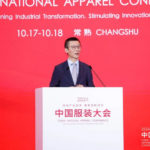
A year ago, researchers from Cornell’s New Conversation Project and the International Labour Organization produced a research brief on COVID-19 impacts on the Asian apparel industry that traced the short-term impacts for workers, suppliers and apparel buyers, and noted the damage wrought by the collapse of global apparel trade in the first half of 2020.
The same Cornell researchers, New Conversations Executive Director Jason Judd and J. Lowell Jackson ’17, have worked again with the ILO to produce “Repeat, Repair of Renegotiate? The Post-COVID Future of the Apparel Industry.” In the paper, they distinguish between industry changes that appear to be new directions brought on by the pandemic, and those that represent accelerations along long-term trajectories, including industry concentration and consolidation, automation, and digitalization and e-commerce for brands and retailers, their suppliers and workers.
“After lots of reporting on COVID’s short-term impacts, we were determined to take a longer view,” said Judd. “Using two decades of data, we found few changes in direction in apparel supply chain labor practices but big accelerations along the curves the industry has been following for years–supplier consolidation, market concentration, a mania for ever-lower wages, and so on.”
To conduct the research, Judd and Jackson completed a literature review to map existing academic, industry and financial research related to the apparel industry. In addition, interviews were conducted with 29 apparel industry experts working in Asia and globally—regulators, apparel brands and retailers, employers and their organizations, unions and labor rights organizations, journalists—between August 2020 and March 2021.
The papers findings are organized in five sections addressing:
- industry acceleration along familiar trajectories and contributes to the literature an analysis of apparel industry concentration, which points toward large, well-capitalized suppliers in Asia receiving ever-larger orders from ever-larger buyers, allowing market concentration and consolidation, automation and digitalization to move together.
- long-term changes in sourcing patterns and practices—including a new analysis of climate change impacts on the geography of apparel production in Asia—and the distribution of risk and cost along global supply chains.
- anticipation of the impacts of these long-term changes on working conditions, wages and industry employment levels with important implications for policymakers at both the producing and consuming ends of fashion’s supply chains.
- the status and future of labor governance, both public and private, and their impacts for suppliers and workers, in particular.
- three progressively optimistic scenarios—Repeat, Repair or Renegotiate—for the future of the apparel industry in Asia and globally.
“The fashion industry has a lot going on,” Judd said. “Over three decades, it has put itself at the center of global crises of overconsumption, environmental damage, income inequality, worker rights, failures of private regulation, and more. The three scenarios our paper describes reflect the big choices the industry has to confront. Repeat is obviously the default choice, but not one that many of the industry’s suppliers and workers can live with.”
The first scenario, “repeat” – a return, where possible, to pre-pandemic trajectories for industry structure, sourcing and governance – is the default ,and extends, where possible, the long-term trajectories of the last decades.
The second scenario, “regain” – in which changes to industry structure and sourcing habits are accelerated, but governance changes, driven by outsiders, are merely accommodated – resembles an accelerated version of the future outlined in the ILO’s 2019 “future of work” paper in which the apparel industry divides more dramatically than in the “repeat” scenario.
The final scenario, “renegotiate” – in which changes to structure, sourcing and governance are integrated and mutually reinforcing – is the most ambitious and hopeful of the three scenarios. It integrates the most desirable, from a decent work perspective, and durable of the possible changes in industry structure, sourcing and governance.
According to Judd and Jackson “This scenario depends on partnership, a collaborative approach to the industry’s challenges that not only reflects the interests of fashion’s ‘outsiders’—suppliers, workers and their organizations, regulators, consumers—but writes their negotiated terms into the contracts and formulas by which the industry operates. This in turn depends on important changes in the industry’s power relationships and the focus here is largely on sourcing and governance.”
(Source: The New York State School of Industrial and Labor Relations, the ILR School)





